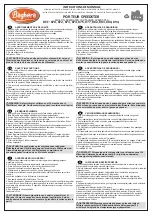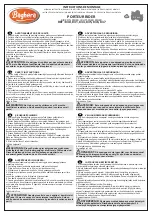
SLASH VXL • 9
TRAXXAS TQ
i
RADIO & VELINEON POWER SYSTEM
TRAXXAS TQ
i
RADIO & VELINEON POWER SYSTEM
NiMH
- Abbreviation for nickel-metal hydride. Rechargeable
NiMH batteries offer high current handling, and much greater
resistance to the “memory” effect. NiMH batteries generally
allow higher capacity than NiCad batteries. They can last up to
500 charge cycles. A peak charger designed for NiMH batteries is
required for optimal performance.
Receiver
- The radio unit inside your model that receives signals
from the transmitter and relays them to the servos.
Resistance
- In an electrical sense, resistance is a measure of how
an object resists or obstructs the flow of current through it.
When flow is constricted, energy is converted to heat and is lost.
The Velineon power system is optimized to reduce electrical
resistance and the resulting power-robbing heat.
Rotor
- The rotor is the main shaft of the brushless motor. In a
brushless motor, the magnets are mounted to the rotor, and the
electromagnetic windings are built into the motor housing.
Sensored
- Sensored refers to a type of brushless motor that
uses an internal sensor in the motor to communicate rotor
position information back to the electronic speed control. The
VXL-3s electronic speed control is able to use sensored motors
when applications benefit from them (such as some sanctioned
racing classes).
Sensorless
- Sensorless refers to a brushless motor that uses
advanced instructions from an electronic speed control to
provide smooth operation. Additional motor sensors and
wiring are not required. The VXL-3s electronic speed control is
optimized for smooth sensorless control.
Servo
- Small motor unit in your model that operates the steering
mechanism.
Solder Tabs
- Accessible, external contacts on the motor that
allows for easy wire replacement. The Velineon 3500 is equipped
with solder tabs.
Transmitter
- The hand-held radio unit that sends throttle and
steering instructions to your model.
Trim
- The fine-tuning adjustment of the neutral position of the
servos, made by adjusting the throttle and steering trim knobs
on the face of the transmitter. Note: The Multi-Function knob
must be programmed to serve as a throttle trim adjustment.
Thermal Shutdown Protection
- Temperature sensing electronics
used in the VXL-3s electronic speed control detect overloading
and overheating of the transistor circuitry. If excessive
temperature is detected, the unit automatically shuts down to
prevent damage to the electronics.
2-channel radio system
- The TQ radio system, consisting of
the receiver, the transmitter, and the servos. The system uses
two channels: one to operate the throttle and one to operate
the steering.
Voltage
- Voltage is a measure of the electrical potential difference
between two points, such as between the positive battery terminal
and ground. Using the analogy of the garden hose, while current is
the quantity of water flow in the hose, voltage corresponds to the
pressure that is forcing the water through the hose.
IMPORTANT RADIO SYSTEM PRECAUTIONS
• For maximum range, always point the front of transmitter toward
the model.
• Do not kink the receiver’s antenna wire. Kinks in the antenna wire
will reduce range.
• DO NOT CUT any part of the receiver’s antenna wire. Cutting the
antenna will reduce range.
• Extend the antenna wire in the model as far as possible for
maximum range. It is not necessary to extend the antenna wire out
of the body, but wrapping or coiling the antenna wire should be
avoided.
• Do not allow the antenna wire to extend outside the body without
the protection of an antenna tube, or the antenna wire may get
cut or damaged, reducing range. It is recommended to keep the
wire inside the body (in the antenna tube) to prevent the chance
of damage.
To prevent loss of radio range
do not kink or cut the black wire,
do not bend or cut the metal tip,
and do not bend or cut the white
wire at the end of the metal tip.
Correct
No
No
No









































